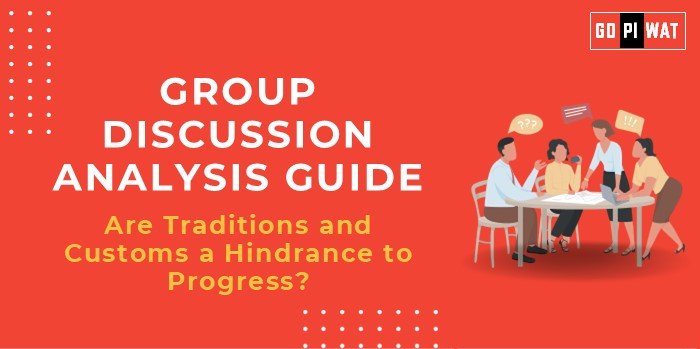📋 Group Discussion (GD) Analysis Guide: Are Traditions and Customs a Hindrance to Progress?
🌐 Introduction to the Topic
Traditions and customs form the bedrock of cultural identity and continuity across generations. However, in an era characterized by rapid modernization, globalization, and technological advances, these long-standing practices are increasingly questioned for their relevance and adaptability. As business leaders aim to drive innovative and inclusive change, evaluating the role of customs and traditions becomes essential in discerning their impact on societal and economic progress.
📊 Quick Facts and Key Statistics
- 🌍 Population Adherence: Over 85% of people worldwide consider traditions an integral part of their lives, demonstrating the deep cultural attachment and resistance to changing norms.
- 💰 Economic Impact: Traditional festivals and customs contribute approximately $1 trillion to the global economy, notably boosting sectors like tourism and crafts.
- 📚 Education Divide: In countries where traditional norms are strongly enforced, female literacy rates often lag by 15-20%, underscoring gender roles rooted in cultural customs.
- 👩💻 Generational Divide: A study shows that 60% of millennials favor progressive changes to traditional practices, reflecting generational shifts in attitudes toward customs.
🔑 Stakeholders and Their Roles
- 🏛️ Government Bodies: Regulate and promote the preservation of cultural heritage, while implementing reforms to mitigate the restrictive aspects of certain customs.
- 🕌 Cultural and Religious Organizations: Advocate for the continuity of traditional values, emphasizing their importance in identity preservation.
- 👥 Citizens: Act as both preservers and reformers of customs, negotiating between tradition and modernity.
- 🌏 International Organizations (UNESCO, WHO): Promote global awareness of cultural preservation and human rights, supporting policies that balance tradition with modern development.
🏆 Achievements and Challenges
✨ Achievements:
- 🎭 Cultural Preservation: Many customs support the preservation of arts, languages, and rituals, fostering unique identities.
- 💸 Economic Boost: Traditional practices and festivals draw tourism, stimulate local economies, and support artisanal industries.
- 🤝 Social Cohesion: Customs often serve to unite communities, establishing shared norms and collective responsibilities.
⚠️ Challenges:
- 🚺 Gender Inequality: Traditional norms sometimes reinforce gender roles that limit economic and social participation, particularly for women.
- ⚕️ Health and Safety Risks: Some customs, such as traditional medicine practices or restrictive dietary laws, may conflict with modern health standards.
- 📉 Innovation Limitation: Emphasis on conventional practices can hinder the adoption of modern methods in fields like education, medicine, and business.
🌍 Global Comparisons:
- 🇯🇵 Japan: Successfully integrates technological advancements with deep respect for tradition, creating a balanced model.
- 🇸🇦 Saudi Arabia: Gradually introduces reforms to modernize customs impacting women’s rights, illustrating a blend of progress and tradition.
📖 Case Studies:
- 🇮🇳 India: Regions like Kerala demonstrate successful integration of traditional values with progressive educational reforms, promoting gender inclusivity.
- 🇳🇬 Nigeria: Undertakes initiatives to modernize traditional practices in the medical field, balancing cultural values with improved healthcare access.
🗣️ Structured Arguments for Discussion
- ✅ Supporting Stance: “Traditions offer a sense of belonging and continuity, which fosters social stability and economic opportunities through cultural industries.”
- ❌ Opposing Stance: “Rigid adherence to customs restricts freedom, innovation, and social mobility, impeding progress in modern societies.”
- ⚖️ Balanced Perspective: “While traditions provide cultural identity, modern society requires adaptations to customs that hinder inclusivity and development.”
💡 Effective Discussion Approaches
- 📊 Opening Approaches:
- “With traditions generating $1 trillion for the economy, it’s crucial to evaluate their role beyond just cultural significance.”
- “In some regions, customs empower communities, while in others, they restrict basic rights.”
- “Saudi Arabia’s reform of women’s rights reflects the struggle between traditional norms and modern standards.”
- 🛠️ Counter-Argument Handling:
- Acknowledge the positive role of traditions in culture and social bonds.
- Provide examples of traditions that adapt to modern values.
- Highlight cases where traditional constraints impede essential rights.
🔍 Strategic Analysis of Strengths and Weaknesses
- 💪 Strengths: Cultural preservation, economic benefits, social cohesion.
- ⚡ Weaknesses: Resistance to change, gender inequality, health risks.
- 🚀 Opportunities: Cultural tourism, innovation within traditions, educational reform.
- 🌪️ Threats: Cultural erosion, human rights violations, economic disparity.
🎓 Connecting with B-School Applications
Real-World Applications: Assessing the impact of customs on industries like tourism, healthcare, and education.
- 📚 Sample Interview Questions:
- “How do traditions shape business strategies in different markets?”
- “What is the role of cultural heritage in a globalized economy?”
- 🌟 Insights for B-School Students: Consider cultural sensitivity in global business, explore modernization of traditional practices, and research cultural influences on consumer behavior.


